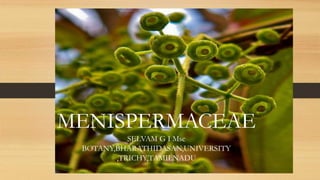
Menispermaceae
- 1. MENISPERMACEAE SELVAM G I Msc BOTANY,BHARATHIDASAN,UNIVERSITY ,TRICHY,TAMILNADU
- 2. SYSTEMATIC POSITION Kingdom Plantae – Plants Subkingdom Tracheobionta – Vascular plants Superdivision Spermatophyta – Seed plants Division Magnoliophyta – Flowering plants Class Magnoliopsida – Dicotyledons Subclass Magnoliidae Order Ranunculales Family Menispermaceae – Moonseed family
- 3. The APG II system (2003; unchanged from the APG system of 1998) recognizes this family and places in the order Ranunculales, in the clade eudicots. Their trimerous flower structure is similar to the Lardizabalaceae and Berberidaceae, although they differ from them in other important characteristics. The APW (Angiosperm Phylogeny Website) considers that they form part of the Order Ranunculales, and that they are a sister group on the branch formed by the Lardizabalaceae and Berberidaceae families in a reasonably advanced clade of the order.
- 5. This family is commonly called as Moonseed family. contains 68 genera with some 440 species.
- 6. DESCRIPTION HABITAT They are distributed throughout low-lying tropical areas with some species present in temperate and arid regions.
- 7. HABIT: Twining woody climbing plants, winding anti-clockwise except Stephania. Rarely upright shrubs or small trees. More rarely still herbaceous plants or epiphytes (Stephania cyanantha). perennial or deciduous, with simple to uni-serrate hairs.
- 8. LEAVES: Alternate spiral leaves, simple, whole, dentate, lobed to palmatifid (bi to trifoliate in Burasaia), petiolated, without stipules, sometimes with spines derived from the petioles (Antizoma). Domatia present in 5 genera as pits or hair tufts. Various types of stomata, frequently cyclocytic.
- 9. STEM : Rapidly growing stems with trilacunar nodes. Phylloclades are present in Cocculus balfourii.
- 10. INFLORESCENCE : racemiform, paniculate or thyrse with partial inflorescences in a capituliform cyme or pseudo-umbel, multifloral, rarely single or paired flowers, axillary or on sharp branches or cauliflorous trunks, females frequently less branched.
- 11. FLOWER : Dioecious plants, sometimes perfect flowers in Tiliacora acuminata and Parabaena denudata.
- 12. Flowers small, regular to zygomorphic (Antizoma, Cyclea, Cissampelos), cyclic to irregularly spiral, hypogynous, basically trimers. Receptacle sometimes with developed gynophore. Sepals (1-)3-12 or more, usually in (1-)2(-many) whorls of 3, rarely 6, free to slightly fused, imbricate or valvate, sometimes less numerous in female flowers. Petals 0-6, in 2 whorls of 3, rarely of 6, free or fused, frequently holding the opposite stamen, sometimes less numerous in female flowers.
- 13. Androecium of (1-)3-6(-40) stamens free of the perianth, free or fused together in 2-5, fasciculate or monadelphous, introrse, dehiscence along longitudinal, oblique or transversal slits. Female flowers sometimes with staminodes. Gynoecium apocarpous, superior, of (1-)3-6(-32) carpels, stigma apical, dry, papilous, ovules 2 per carpel, anatropous, hemianatropous to campilotropous, uni- or bitegmic, crassinucellate, the superior epitropous and fertile, the inferior apotropous and abortive, placentation marginal ventral. Male flowers sometimes with carpelodes.
- 14. Fruit compound, each unit in a straight or flattened, asymmetric drupe, more or less stipitate (rarely only one developed), Exocarp membranous, mesocarp pulpy, fleshy or fibrous, endocarp woody to petrous, rough, tuberous, echinate or ribbed, often with a recess in the placenta called a condyle. Seeds slightly curved or spiral (Limaciopsis, Spirospermum), with endosperm absent or present. embryo straight or curved, with two cotyledons flat or cylindrical, leafy or fleshy. Chromosomal number: x = 11, 13, 19, 25. 2n can be up
- 15. It is thought that the cauliflorous species are pollinated by small bees, beetles or flies although there are no direct observations of this. Birds disperse the purple or black drupes, for example Sayornis phoebe (Tyrant flycatcher) eats the fruit of Cocculus. In Tinospora cordifolia a lapse of 6–8 weeks has been observed between fertilization and the first zygotic cell division.
- 16. Phytochemistry The family contains a wide range of benzylisoquinoline compounds (alkaloids) and lignans such as furofuran, flavones and flavonols and some proanthocyanidins. The most notable are the wide variety of alkaloids derived from benzyltetrahydroisoquinoline and aporphine, which accumulate as dimers, as well as the alkaloids derived from morphinan and from hasubanan and other diverse types of alkaloid such as derivative of aza-fluoranthene.
- 17. Sesquiterpenes such as picrotoxin and diterpenes such as clerodane diterpene are also present, while the triterpenes are scarce and where present are similar to oleanane. Ecdysone steroids have also been found. Some species are cyanogenic.
- 18. ECONOMIC IMPORTANCE The menispermaceae have been used in traditional pharmacopeia and drugs have been formulated from these plants that are of great use in modern medicine. These drugs are based on alkaloids and include tubocurarine from curare, a poison used by indigenous South American tribes on their poison darts, that is obtained from species of Curarea, Chondrodendron, Sciadotenia and Telitoxicum. A similar poison was used in Asia (ipos) that was obtained from species of Anamirta, Tinospora, Coscinium and Cocculus.
- 19. Tubocurarine and its synthetic derivatives are used to relax muscles during surgical interventions. The roots of "kalumba" or "colombo“ (Jateorhiza palmata) are used in Africa for stomach problems and against dysentery.
- 20. Species of Tinospora are used in Asia as antipyretics, the fruit of Anamirta cocculus is used to poison fish and birds and the stems of Fibraurea are used to dye fabric yellow.
- 21. THANK YOU